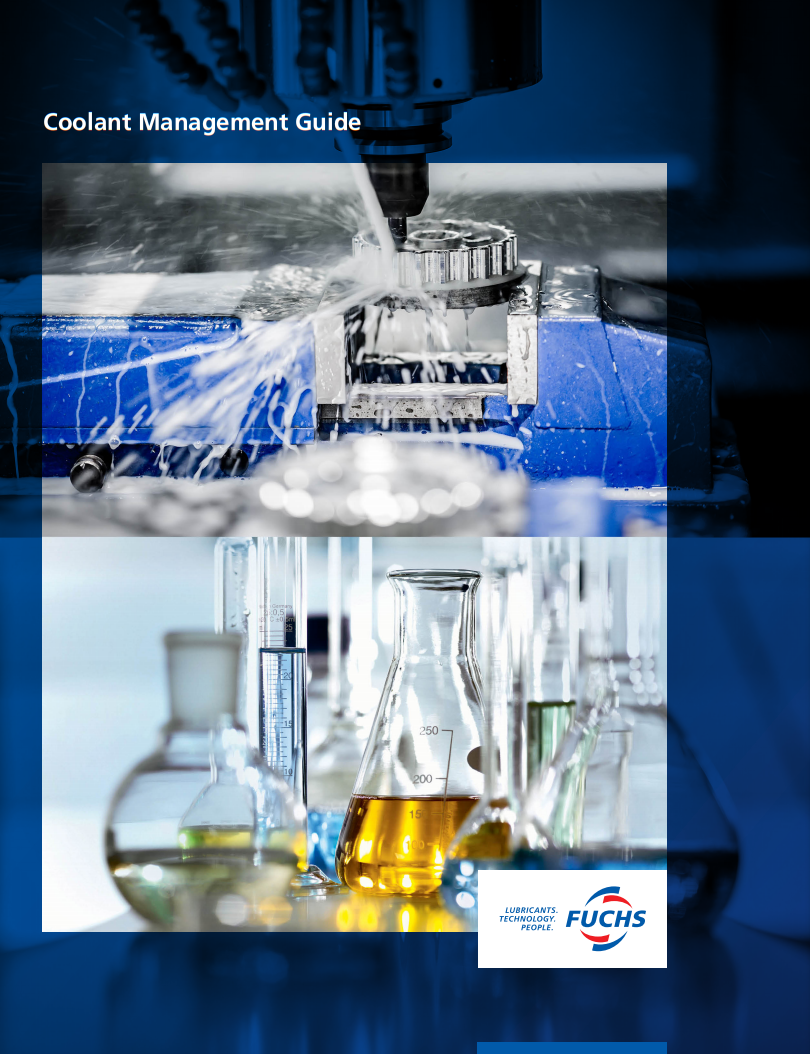MONITORING OF CUTTING FLUIDS
FUCHS Lubricants water-miscible cutting fluids meet all regulatory requirements and offer reliable performance and optimum service life. Sustainability and workplace environment is incorporated into the products.
A variety of disruptive factors can alter the application engineering characteristics of water-miscible cutting fluids. Routine monitoring of the cutting fluid is, therefore, necessary to ensure that the fluid is in optimum condition and that the hazard potential for people and the environment is kept as low as possible.
Concentration control is critical for the overall performance of water-miscible metalworking fluids. Low concentrations can result in poor machinability, increased corrosion and poor product stability. High concentrations can lead to foaming, misting, smoking and increased dermal and respiratory irritation, especially in the metalworking industry.
To achieve the objectives of economic use and cost reductions when water-miscible cutting fluids are used, it is essential that the properties of the product used are maintained for as long as possible. Apart from the product’s quality and the machining process involved, the service life of a cutting fluid is significantly influenced by the fluid’s monitoring and the maintenance substances used along with their scope and continuity. Experience shows that these days it is easier to achieve economic service life with central circulation systems than with individually filled machines. However, it is also true that if cutting fluid manufacturer’s or professional association’s recommendations are strictly observed and consistently applied, individually filled machines can also achieve very long fluid service lives.
Apart from service life optimisation, safety at work also plays an important role. Legislation requires users to fulfil safety at work requirements by keeping cutting fluids in perfect condition. It therefore follows that the monitoring and maintenance measures during a fluid’s use in machining processes, i.e. analyzing emulsion condition and the use of maintenance equipment, is immensely important.
The following describes a few simple tests which users can perform on site:
a) Visual checks
In the forefront are two important checks which should be performed daily. The first is a basic prerequisite for keeping cutting fluids in good condition and involves checking the cutting fluid level in the tank. In machine tools with insufficient cutting fluid in the tank, the circu- lation pump can draw air and this can lead to cutting emulsion foaming. This, in turn, can lead to other problems such as inadequate heat dissipation from the tool and component and thus reduced performance such as grinding burns or reduced tool life. The second visual evaluation of the emulsion concerns emulsion colour and degree of dispersion. If optical changes to the cutting fluid occur, this is usually an indication of a change in the condition of the cutting fluid. This requires specific counter-measures which must be accompanied by a comprehensive review of the causes. Normally, an emulsion does not have floating or creamy oil on its surface.
As it is often difficult to perform further evaluations of the cutting fluid in the emulsion tanks, we recommend taking an emulsion sample in a clean and transparent container (glass or transparent plastic) and then examining and evaluating this sample.
There can be a number of reasons why a cutting fluid displays changes and these can be clarified by the monitoring parameters
b) pH value measurement
A pH value measurement must be performed at least once a week (TRGS 611). The simplest way is to use test strips which show the pH value by colour indication. These can be used at any time and do not require calibration. However, it should be remembered that such indicator test strips have a use-by date. If the test strips are too old, inaccuracies can occur due to colour errors.
A very important consideration when using all test strip methods is the correct handling of the strips. This includes the dipping of the test strip into clean emulsion which does not have tramp oil floating on top. Furthermore, time is important, i.e. how much time should elapse before the test strip is evaluated. The advantages of the test strip method are its speed and simplicity without the need for additional reagents. The method is thus relatively immune to erroneous readings caused by handling errors.
A somewhat more accurate but more costly alternative to pH measurements with test strips is to use an electrical pH value measurement instrument. Regardless of whether a battery operated pocket instrument or a laboratory instrument, it is important that operators know how to handle the pH electrode as regards cleanliness and the necessity of routine recalibration prior to measurements. In addition, it is necessary to ensure that the measurement head (diaphragm) is clean so that no tramp oil can interfere with the measurements which inevitably lead to false readings.
An important point for pH value measurements and the corresponding documentation is the development of the pH value over the course of the emulsion’s service life. The continuous monitoring of pH values allows countermeasures to be taken in good time.
c) Concentration measurement
It is recommended that the concentration of the emulsion is tested at least once a week and even daily if the emulsion volume is small and/or it is used in highly-stressed machining centers with high drag-out. For this, there are simple and cost-effective methods available. One possible concentration measurement tool which should be available in all metalworking workshops is the hand-held refractometer.
Hand-held refractometer This instrument is used to optically determine concentration along with the cutting fluid-specific refractometer factor which can be found in the respective Product Information by measuring the refraction of light (refractive index) through the medium. The value seen on the measurement scale which corresponds to the clear, boundary between the colours is then multiplied by the cutting fluid-specific factor to generate the emulsion concentration value.
When using a hand-held refractometer, it is important to set the zero point adjustment with pure water prior to any concentration measurements. A heavily contaminated or less than stable emulsion or one which has excessive tramp oil can lead to the dividing line being diffused which, in turn, caused inaccurate or unsafe concentration measurements. Normally, concentration measurements with hand-held refractometers generate almost identical values both immediately after the sample has been taken and after many hours. However, if the emulsion is not stable, the values may differ significantly.
Titration Another way of determining concentration is titration. This is a quantitative method. A corresponding colour indicator is added to the emulsion sample of unknown concentration. Using a burette, a titrant (for example, 0.1 mol/l HCl) is added drop by drop to a defined volume of the sample until the colour changes at the equivalence point. The concentration of the emulsion can then be determined with the titrant consumption and the product- specific titration factor of the cutting fluid.
Some cutting fluid manufacturers offer titration sets with which it is possible to determine concentration directly at the machine with the help of a titration curve. Information about other titration methods can be obtained from the cutting fluid manufacturers.
d) Nitrite content
Another parameter which is required to monitor cutting fluids is nitrite content. Against the background of avoiding hazards to employees caused by nitrosamine contamination, the nitrite content of cutting fluids should be determined weekly. Nitrite is a reaction component which together with secondary amines can lead to the creation of carcinogenic nitrosamines.
Nitrite can be formed by the nitrate in the mixing water but is not a substance contained in cutting fluids. Because cutting fluids containing secondary amines are banned, this second reagent (for example diethanolamine) which can lead to the creation of nitrosamines is largely excluded. However, contamination through the drag-in of other media cannot be completely excluded.
(TRGS 611) As measurements show, limiting nitrite concentration to less than 20 ppm provides sufficient guarantee that the permissible MAK value of 5 ppm nitrosodiethanolamine in the emulsion is not exceeded. If these values are higher than 20 ppm, it is essential that the source of the nitrite is found. If such a source, such as quenching salts, is found, this must be eliminated or excluded. Further measures to reduce nitrite could include partial replacement or the use of fresh cutting fluid. (BGR/ GUV-R-143).
e) Nitrate content
As already mentioned, nitrite can originate from the nitrate in the mixing water and this should therefore be regularly checked. Test strips are also available for this purpose. According to drinking water regulations, a maximum of 50 ppm nitrate is allowed. As a rule, nitrate concentrations are between 10 and 20 ppm. However, significantly higher concentrations than 20 ppm may be found in regions of intensive agricultural activity.
Nitrate monitoring does not have to happen on a weekly basis. Nevertheless, we recommend that this value is routinely checked or, at least, have the nitrate value confirmed by the local water supplier and documented.
Apart from simply evaluating the test strips visually, there is also the possibility automatically reading the strips with a so-called “Reflectoquant system”. This option may be of interest if a large number of individually filled machines have to be monitored.
f) Water hardness
Another check which can be of benefit but is not mandatory, particularly in the case of individually filled machines with high replenishment volumes, is testing water hardness.
This is often the case if the mixing water contains well water. Here again, there is the possibility of using economical and simple-to-use test strips to test for any increase in hardness. Very high levels of water hardness can result from high evaporation losses.
The influence of water hardness on emulsion stability is judged to be non-critical for the large majority of today’s cutting fluids. A greater problem is the water hardness-related deposits and gumming which can affect metalworking machines along with the associated high cleaning costs. But such burdens add up and excess hardness can certainly negatively affect emulsion service life which ceases to be optimum and too hard water can necessitate costly rust-related rectification work.
If checking water hardness and possible correction by adding demineralized water eliminates a burden to the emulsion, service life can be significantly increased.
Please consult the Product Information Sheet or contact your FUCHS representative for recommended concentration ranges. Email: Za-contact-za@fuchs.com or find a cutting fluid here:
https://www.fuchs.com/za/en/industries/f-m/metal-processing/


